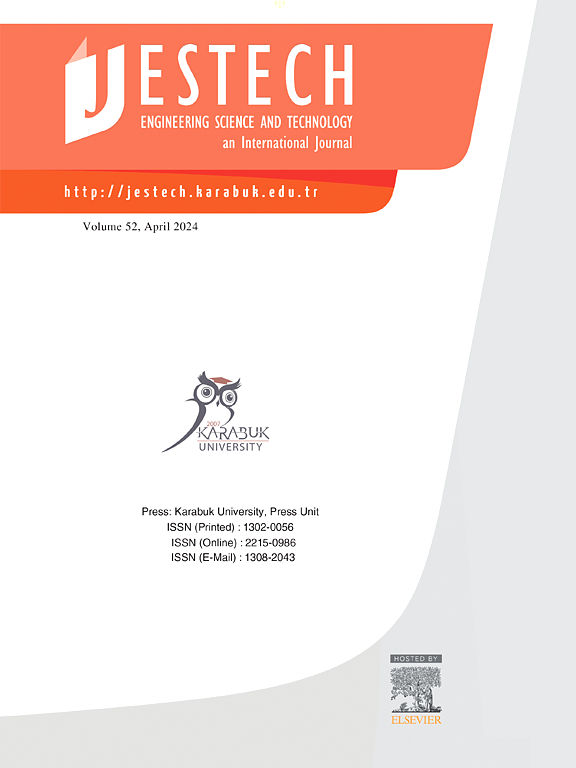Experimental investigation of the effect of nano fluid use on heat transfer in unmanned aircraft cooling system with different types of wing geometry
IF 5.1
2区 工程技术
Q1 ENGINEERING, MULTIDISCIPLINARY
Engineering Science and Technology-An International Journal-Jestech
Pub Date : 2025-04-05
DOI:10.1016/j.jestch.2025.102059
引用次数: 0
Abstract
Unmanned aerial vehicles (UAVs) have performed critical tasks such as air dominance, national security, wildlife surveillance, damage detection studies after natural disasters, early intervention in forest fires, management activities, explosions, and logistics. UAVs, which perform these critical tasks and whose importance has been increasing in the world in recent years, experience a loss of thermal efficiency in their cooling systems at critical times during flight. In order to optimize cooling mechanisms for UAVs, this study aims to redesign existing cooling fins. In addition, it is planned to use nanofluids instead of traditional coolants in these radiators. In addition to the increased cooling performance with the use of nanofluid, it has been determined that this effect is further increased by the use of new design parts (Radiator-F1, Radiator-F2, Radiator-F3) consisting of louver type fin structures with different fin geometries in number and pattern compared to standard flat fins (Radiator-S). In these newly designed cooling systems were tested at flow rates of 20 and 22 lt/min, a temperature of 70 °C, and an inlet pressure of 0.2 bar are focused on increasing the cooling efficiency of the coolers. Experiments were carried out on standard and newly designed radiators using Al2O3, ZnO and CuO nanofluids at 0.3 % volumetric concentration for thermal performance measurement. The heat transfer in Radiator-S using pure water was calculated as 9.02 kW. The heat transfer amount in the newly designed Radiator-F1 using pure water was the highest and increased by approximately 23 %. The heat transfer increase in Radiator-F1 using CuO nanofluid was the highest and was determined to be approximately 38 % compared to using pure water in Radiator-S. Thermal conductivity and viscosity ratios increased compared to pure water. The highest increase in thermal conductivity was approx 18 % in ZnO nanofluid and viscosity was approx 16 % in Al2O3 nanofluid.
The improvement resulting from the findings increases the operational capabilities of the (UAVs). In addition, the lightness resulting from a more compact system indirectly increases the flight duration. These results demonstrate significant improvements in cooling performance for UAV applications.
纳米流体对不同机翼几何形状无人机冷却系统传热影响的实验研究
无人驾驶飞行器(uav)执行了诸如空中优势、国家安全、野生动物监视、自然灾害后的损害检测研究、森林火灾的早期干预、管理活动、爆炸和物流等关键任务。执行这些关键任务的无人机,其重要性近年来在世界范围内日益增加,在飞行过程中的关键时刻,其冷却系统会出现热效率损失。为了优化无人机的冷却机制,本研究旨在重新设计现有的冷却鳍。此外,计划在这些散热器中使用纳米流体代替传统的冷却剂。除了使用纳米流体提高冷却性能外,已经确定使用新的设计部件(散热器- f1、散热器- f2、散热器- f3)进一步提高了这种效果,这些部件由百叶窗型鳍结构组成,与标准平板鳍(散热器- s)相比,它们在数量和图案上都有不同的鳍形几何形状。在这些新设计的冷却系统中,在流速为20和22 lt/min,温度为70°C,入口压力为0.2 bar的情况下进行了测试,重点是提高冷却器的冷却效率。采用体积浓度为0.3%的Al2O3、ZnO和CuO纳米流体对标准散热器和新设计的散热器进行了热性能测试。经计算,纯水在散热器s内的换热量为9.02 kW。新设计的纯水散热器- f1的换热量最高,提高了约23%。与在散热器- s中使用纯水相比,使用CuO纳米流体的散热器- f1的传热增加幅度最大,约为38%。与纯水相比,导热系数和粘度比增加。ZnO纳米流体的热导率增加了约18%,Al2O3纳米流体的粘度增加了约16%。改进结果增加了(uav)的作战能力。此外,更紧凑的系统所带来的轻便性间接地增加了飞行时间。这些结果表明,无人机应用的冷却性能有了显著改善。
本文章由计算机程序翻译,如有差异,请以英文原文为准。
求助全文
约1分钟内获得全文
求助全文
来源期刊

Engineering Science and Technology-An International Journal-Jestech
Materials Science-Electronic, Optical and Magnetic Materials
CiteScore
11.20
自引率
3.50%
发文量
153
审稿时长
22 days
期刊介绍:
Engineering Science and Technology, an International Journal (JESTECH) (formerly Technology), a peer-reviewed quarterly engineering journal, publishes both theoretical and experimental high quality papers of permanent interest, not previously published in journals, in the field of engineering and applied science which aims to promote the theory and practice of technology and engineering. In addition to peer-reviewed original research papers, the Editorial Board welcomes original research reports, state-of-the-art reviews and communications in the broadly defined field of engineering science and technology.
The scope of JESTECH includes a wide spectrum of subjects including:
-Electrical/Electronics and Computer Engineering (Biomedical Engineering and Instrumentation; Coding, Cryptography, and Information Protection; Communications, Networks, Mobile Computing and Distributed Systems; Compilers and Operating Systems; Computer Architecture, Parallel Processing, and Dependability; Computer Vision and Robotics; Control Theory; Electromagnetic Waves, Microwave Techniques and Antennas; Embedded Systems; Integrated Circuits, VLSI Design, Testing, and CAD; Microelectromechanical Systems; Microelectronics, and Electronic Devices and Circuits; Power, Energy and Energy Conversion Systems; Signal, Image, and Speech Processing)
-Mechanical and Civil Engineering (Automotive Technologies; Biomechanics; Construction Materials; Design and Manufacturing; Dynamics and Control; Energy Generation, Utilization, Conversion, and Storage; Fluid Mechanics and Hydraulics; Heat and Mass Transfer; Micro-Nano Sciences; Renewable and Sustainable Energy Technologies; Robotics and Mechatronics; Solid Mechanics and Structure; Thermal Sciences)
-Metallurgical and Materials Engineering (Advanced Materials Science; Biomaterials; Ceramic and Inorgnanic Materials; Electronic-Magnetic Materials; Energy and Environment; Materials Characterizastion; Metallurgy; Polymers and Nanocomposites)
 求助内容:
求助内容: 应助结果提醒方式:
应助结果提醒方式:


